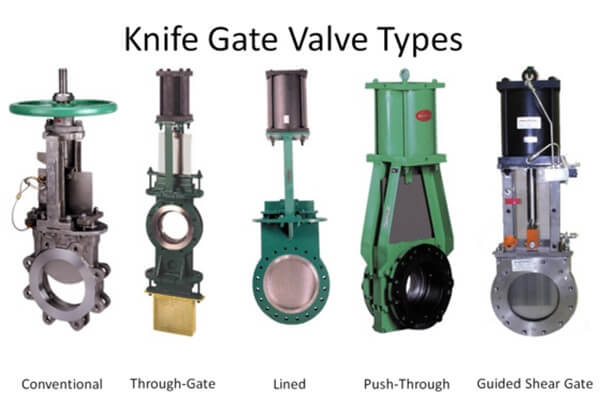Knife gate valves are widely used in industries like mining, wastewater, pulp & paper, and chemical processing due to their ability to handle slurries, viscous fluids, and solids-laden media. Choosing the right type of knife gate valve ensures better performance, sealing, and durability for specific applications.

What Is a Knife Gate Valve?
A knife gate valve uses a sharp-edged blade (knife) to cut through solid particles and isolate flow. It’s primarily designed for on/off applications in systems with low-pressure drops. The design prevents clogging in abrasive or thick fluids, which would quickly damage conventional valves.
Main Types of Knife Gate Valves
1. Unidirectional Knife Gate Valve
Flow Direction: Designed for flow in one direction only.
Sealing: Seals on the downstream side.
Applications: Suitable for dry bulk materials or light slurry.
Pros: Lower cost, simpler design.
Cons: Limited versatility due to one-way sealing.
2. Bidirectional Knife Gate Valve
Flow Direction: Can seal in both flow directions.
Sealing: Uses enhanced seat designs to ensure tight shut-off.
Applications: Ideal for slurry, wastewater, and industrial processing where flow can reverse.
Pros: Greater flexibility, better sealing for liquids.
Cons: Slightly more expensive.
3. Lug Type Knife Gate Valve
Design: Features threaded lugs for easy installation between flanges.
Applications: Used where isolation of one side of the piping system is needed.
Pros: Can be installed in end-of-line service.
Cons: Typically heavier and costlier than wafer types.
4. Wafer Type Knife Gate Valve
Design: Slim, lightweight, and mounted between flanges with bolts.
Applications: Used in low-pressure, low-cost systems.
Pros: Compact design, cost-effective.
Cons: Not suitable for high-pressure applications.
5. Through-Gate (Full Lug) Knife Gate Valve
Design: Features a gate that passes fully through the valve body.
Applications: Ideal for high-cycle operations and slurry-heavy environments.
Pros: Reduced wear on seats, easier maintenance.
Cons: Larger footprint.
6. O-Ring or Soft-Seated Knife Gate Valve
Sealing: Utilizes elastomer or soft seals for bubble-tight shut-off.
Applications: Perfect for water, wastewater, and slurry with fine solids.
Pros: Excellent sealing performance.
Cons: Seat material can wear out faster in abrasive conditions.
7. Metal-Seated Knife Gate Valve
Sealing: Metal-to-metal seat for high temperature and abrasive media.
Applications: Pulp & paper, mining, or chemical plants with tough conditions.
Pros: Long life in extreme environments.
Cons: May not provide bubble-tight sealing.
8. Hopper-Shape Knife Gate Valve
Design: Designed for dry powders, bulk solids, and granules.
Applications: Cement, grain handling, or bulk material storage.
Pros: Reduces clogging with bulk materials.
Cons: Specialized and more expensive.
How to Choose the Right Type of Knife Gate Valve
Media: Is it slurry, clean liquid, or dry solids?
Pressure Rating: Low, medium, or high pressure?
Flow Direction: Will the flow reverse? (Unidirectional vs. bidirectional)
Installation Needs: Lug vs. wafer vs. through-gate designs.
Temperature & Abrasion: Metal seat vs. soft seat.
Conclusion
Understanding the different knife gate valve types—such as unidirectional, bidirectional, lug, wafer, and metal-seated valves—ensures the best fit for your application. Each type is designed to handle specific challenges, from abrasive slurries to bulk solids.
Looking for high-performance knife gate valves? Contact us for recommendations and competitive pricing tailored to your industry.
